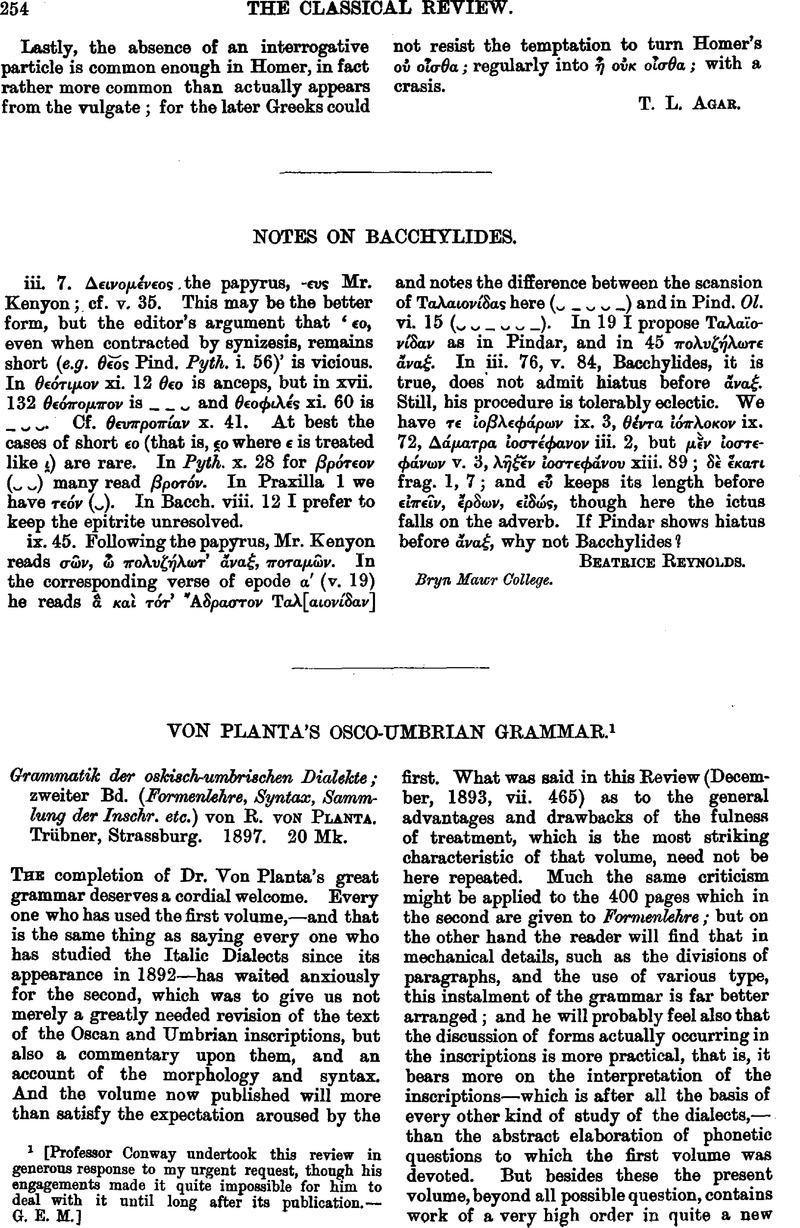No CrossRef data available.
Article contents
Von Planta's Osco-Umbrian Grammar - Grammatik der oskisch-umbrischen Dialekte; zweiter Bd. (Formenlehre, Syntax, Sammlung der Inschr. etc.) von R. von Planta. Trübner, Strassburg. 1897. 20 Mk.
Published online by Cambridge University Press: 27 October 2009
Abstract

- Type
- Reviews
- Information
- Copyright
- Copyright © The Classical Association 1898
References
page 255 note 1 Chiefly those of Sulmona, Capua, and the Naples Museum (though here with some omissions); the more outlying inscc, in Rome, London, Berlin, and Vienna, and all the coins he has taken from other authorities, which are generally quite adequate.
page 255 note 2 Brugmann's analysis of the ‘ablative’ of the gerund, e.g. regundō, into this inf. + the postposn. -dō, ‘to,’ appears to me to be established by one or two points in its usage which I hare not seen quoted in this connexion: (1) by the fact that the abl. of the gerund is far more common than e.g. the genitive ; (2) by the remarkable freedom of the use of the abl. as the equivalent of a modal active partc. (whence indeed the Italn. and Span. act. partcc. are derived) where, it is to be noticed, the gerundive is comparatively rarely substituted for it (e.g. Liv. 1, 8, conciendo ad se multitudinem, and continually in the historians); (3) by the far greater frequency of the use of the gerund with ad than with any other prepn., in which one may see an echo of the earliest use of the form in -dō to express purpose, as it still does in the ‘dative’ use.
The gerundive, however, still seems to me to have been a present partc. in -oni⌢os, -eni⌢os (for the phonetics cf. tendo : τε⋯νω), whose use was severely and peculiarly restricted by its association with the ‘gerund’ forms, as Roby long since maintained.
page 256 note 1 The only exception to this is the limitation implied in the title ; no dialects are recognised outside the Osco-Umbrian group ; thus those nearest to Latin, like Faliscan, are left out, save for one or two specimens thrown in at the end.
page 256 note 2 To No. 296a toce stahu, which is given as an insc. not hitherto published, I venture to think a similar note might have been added. It looks like the work of a forger who took at random two words from known Umbr. inscc. in Latin alphabet, producing a fragment which declares that ‘I am dedicated to (or on) bacon’!
page 256 note 3 This thoroughly misleading term (now promoted to a third meaning) seems to die hard.
page 256 note 4 I can vouch for the last three letters as οσι, though they are very difficult to make out on the edge of the gem.
page 257 note 1 Von Planta suggests that it was written in the ‘sad, meddix-less period’ of the siege, 214–211 B.C., but this does not seem to make the sentence much clearer.




